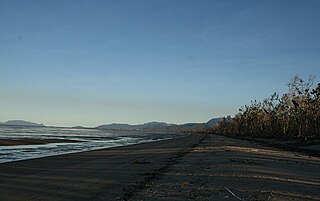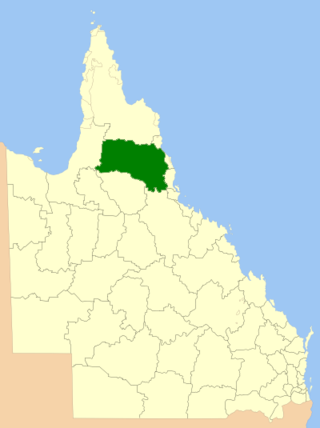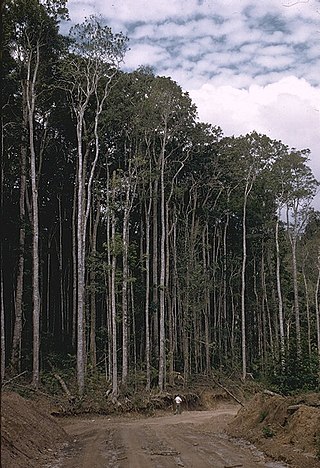Related Research Articles

The Daintree National Park is located in Far North Queensland, Australia, 1,757 km (1,092 mi) northwest of Brisbane and 100 km (62 mi) northwest of Cairns. It was founded in 1981 and is part of the Wet Tropics of Queensland. In 1988, it became a World Heritage Site. The park consists of two sections—Mossman Gorge and Cape Tribulation, with a settled agricultural area between them which includes the towns of Mossman and Daintree Village.

Girramay is a national park in Queensland, Australia, 1269 km northwest of Brisbane. The national park is part of the Wet Tropics World Heritage Area.

Eubenangee Swamp is a national park in Eubenangee in the Cairns Region, Queensland, Australia, 1332 km northwest of Brisbane. It is part of the Coastal Wet Tropics Important Bird Area, identified as such by BirdLife International because of its importance for the conservation of lowland tropical rainforest birds. It plays home to over 190 species of birds.
Hull River is a national park in Queensland (Australia), 1275 km northwest of Brisbane. GIS mapping data from Queensland Department of Natural Resources (2002) showed an area of 3,240 hectares, of which about 2,100 hectares are estuarine mangroves, with the remainder being swamp forests dominated by Melaleuca and specialist Eucalypt species. Rainfall averages 3,600 mm per year. The park is part of the Coastal Wet Tropics Important Bird Area, identified as such by BirdLife International because of its importance for the conservation of lowland tropical rainforest birds.
Girringun National Park is a national park in Queensland, Australia, approximately 50 kilometres (31 mi) southwest of Ingham, 110 kilometres (68 mi) north of Townsville and 1,290 kilometres (800 mi) northwest of Brisbane. The park is one of the Wet Tropics World Heritage Area series of national parks, and is a gazetted World Heritage Site.

The Main Range is a mountain range and national park in Queensland, Australia, located predominantly in Tregony, Southern Downs Region, 85 kilometres (53 mi) southwest of Brisbane. It is part of the World Heritage Site Gondwana Rainforests of Australia. It protects the western part of a semicircle of mountains in South East Queensland known as the Scenic Rim. This includes the largest area of rainforest in South East Queensland. The park is part of the Scenic Rim Important Bird Area, identified as such by BirdLife International because of its importance in the conservation of several species of threatened birds.

Tropical and subtropical moist broadleaf forests (TSMF), also known as tropical moist forest, is a subtropical and tropical forest habitat type defined by the World Wide Fund for Nature.

The Wet Tropics of Queensland World Heritage Site consists of approximately 8,940 km2 of Australian wet tropical forests growing along the north-east Queensland portion of the Great Dividing Range. The Wet Tropics of Queensland meets all four of the criteria for natural heritage for selection as a World Heritage Site. World Heritage status was declared in 1988, and on 21 May 2007 the Wet Tropics were added to the Australian National Heritage List.
Margaret Grace Thorsborne was an Australian naturalist, conservationist and environmental activist. She was notable for her efforts, with her husband Arthur Thorsborne, in initiating the long-term monitoring and protection of the Torresian imperial-pigeon on the Brook Islands, north east of Hinchinbrook Island, Far North Queensland. Toward the end of her life, she was involved in the struggle to protect Queensland’s Wet Tropics World Heritage Area and animals such as the southern cassowary, mahogany glider and dugong.
Bernard Hyland, known as Bernie Hyland, is an Australian botanist.

Ninney Rise and John Busst Memorial are a heritage-listed house and memorial at 405 Alexander Drive and Esplanade, Bingil Bay, Cassowary Coast Region, Queensland, Australia. It was designed by John Busst and built circa 1960 by John Busst. It is also known as John and Alison Busst's Residence. It was added to the Queensland Heritage Register on 6 August 2010.
John Horatio Busst was an artist and conservationist in Queensland, Australia. He is best known for leading a successful campaign to protect Queensland's Great Barrier Reef and its tropical rainforests from development, mining pressures and exploitation.

The Windsor Tablelands are a series of plateaus located in Far North Queensland, Australia. The Windsor Tableland and surrounding rainforest area are contained as part of the Wet Tropics of Queensland, sitting between the Daintree Rainforest and Mount Lewis National Park. Additionally, the region is contained in the state electorate of Cook and situated in the greater Tablelands Region of North Queensland. The Tablelands hug the mountain ranges of the Great Dividing Range with the nearest town being Wujal Wujal. The Tableland area is a larger part of the Mount Windsor Forest Reserve which represents 44,000 hectares of land in the Wet Tropic region and is a conserved nature area, as proclaimed by the Government of Queensland in 2005. Predominately the majority of the Mount Windsor Tableland is closed off for any form of public use and access to the area is often only given on request. There is currently no residential population in the Mount Windsor Tableland region as a majority of the area is national park.

Jim Gasteen (1922–2017) was an Australian farmer and conservationist, responsible for the establishment of a number of National Parks in Queensland and New South Wales.

James Peter Stanton is an Australian landscape ecologist, fire ecologist, botanist and biogeographer who individually conducted systematic environmental resource surveys throughout Queensland whilst working for the National Parks department of Forestry (Qld.) from 1967–1974. He carried out his assessments in a range of dissimilar landscapes leading to the identification and protection of many critically threatened ecosystems across the state during a period of rapid and widespread land development under the Joh Bjelke-Petersen government. For this work he became the first Australian to receive the IUCN Fred M. Packard Award in 1982.
Tully Training Area is a heritage-listed rainforest in a military training area at Tully-Cardstone Road, Tully, Queensland, Australia. It was added to the Australian Commonwealth Heritage List on 22 June 2004.

John Geoffrey Tracey was an Australian ecologist and botanist whose pioneering research work in partnership with Dr. Leonard Webb within the Rainforest Ecology Unit of the CSIRO in the 1950s led to the publication of the first systematic classification of Australian rainforest vegetation in the Journal of Ecology in 1959. By the early 80's, after decades of ongoing research, Tracey and Webb had accumulated a significant corpus of scientific evidence in support of the theory that Australian tropical rainforests had evolved in Gondwana over 100 million years ago and were not, as previously believed, relatively recent arrivals from South East Asia. This evidence, in combination with Tracey and Webb's 1975 publication of a collection of 15 vegetation maps entitled "Vegetation of the Humid Tropical Region of North Queensland", and Tracey's 1982 paper "The Vegetation of the Humid Tropical Region of North Queensland", helped to establish the scientific basis for a number of major conservation campaigns across Queensland and paved the way for the subsequent successful World Heritage nomination of the Wet Tropics of Queensland by Aila Keto in 1988.

Leonard James Webb was a widely awarded Australian ecologist and ethnobotanist who was the author or joint-author of over 112 scientific papers throughout the course of his professional career. His pioneering work as Senior Principal Research Scientist alongside Geoff Tracey in the CSIRO Rainforest Ecology Research Unit in the 1950s led to the publication of the first systematic classification of Australian rainforest vegetation in the Journal of Ecology in 1959.

Hilda Geissmann was a pioneering Australian botanist, naturalist and photographer whose botanical and ornithological research within the Mount Tamborine area of South East Queensland significantly contributed to the early ecological understanding of the region.
Samuel Justin Dansie was an Australian forester and botanist who was an influential early figure associated with the emergence of a conservation ethos in the use and management of the Wet Tropical rainforests of Northern Queensland. During his 36-year tenure within the Queensland Forestry Department, Dansie was instrumental in identifying and securing the protection of a number of key conservation areas, both within and outside of state forests in the region.
References
- ↑ Rainforest Conservation Society of Queensland; Australian Heritage Commission (1986), Tropical rainforests of North Queensland their conservation significance : a report to the Australian Heritage Commission, Canberra Australian Govt. Pub. Service, ISBN 978-0-644-04099-0
- ↑ Rainforest Conservation Society Inc; Keto, Aila; Scott, Keith (1992), The central eastern rainforests of Australia : World Heritage nomination, Rainforest Conservation Society, retrieved 14 October 2021
- 1 2 "Packard Awardees". IUCN. 19 February 2016.
- 1 2 "Award Extract - Australian Honours - Aila Keto". Australian Government - Department of the Prime Minister and Cabinet. Retrieved 13 October 2021.
- 1 2 "Award Extract - Australian Honours - Aila Keto". Australian Government - Department of the Prime Minister and Cabinet. Retrieved 13 October 2021.
- 1 2 "Volvo awards protection of biodiversity". Volvo Environment Prize. Archived from the original on 8 January 2008. Retrieved 28 February 2008.
- ↑ "2005 Queensland Greats recipients". Queensland Government. Archived from the original on 31 May 2017. Retrieved 31 May 2017.
- ↑ "2005 Queensland Greats recipients". Queensland Government. Archived from the original on 31 May 2017. Retrieved 31 May 2017.
- ↑ "Keto, Aila Inkeri (1943 - )". Bright Sparcs Biographical entry. Retrieved 29 February 2008.
- ↑ "Keto, Aila Inkeri". WomenInAustralia.info. Retrieved 16 November 2020.
- ↑ Williams, Christine (2006). Green power: Environmentalists who have changed the face of Australia, Lothian Books, pp. 87-96.
- 1 2 "Aila Keto Selected as a "Queensland Great" 2005". Australian Rainforest Conservation Society. Archived from the original on 21 March 2008. Retrieved 28 February 2008.
- ↑ Stanton, J. P. (James Peter); Borschmann, Gregg (1994), Peter Stanton interviewed by Gregg Borschmann in the Environmental awareness in Australia oral history project, pp. 126, 127
- ↑ Tracey, J. G. (John Geoffrey); Borschmann, Gregg (1994), John Tracey interviewed by Gregg Borschmann in the People's forest oral history project, p. 64